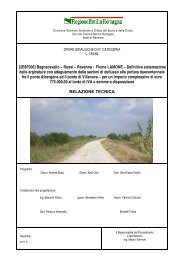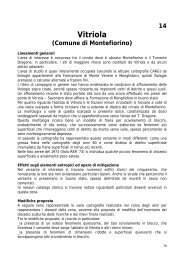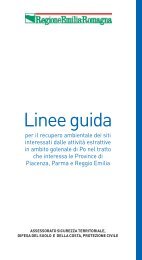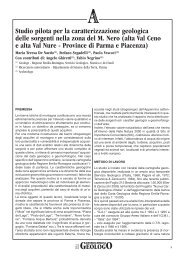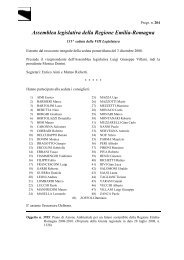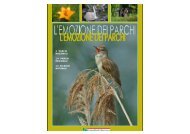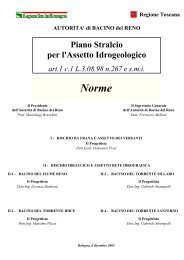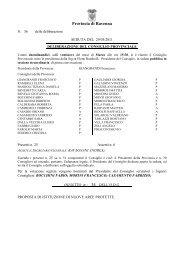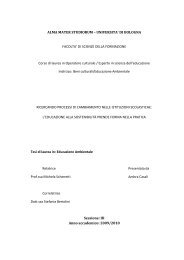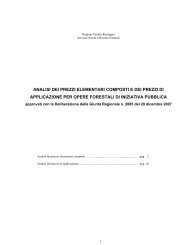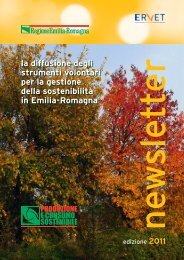air, water and soil quality qualité - ER Ambiente - Regione Emilia ...
air, water and soil quality qualité - ER Ambiente - Regione Emilia ...
air, water and soil quality qualité - ER Ambiente - Regione Emilia ...
You also want an ePaper? Increase the reach of your titles
YUMPU automatically turns print PDFs into web optimized ePapers that Google loves.
Autonomous Republic included in Uzbekistan, <strong>and</strong> its first ethnic group is<br />
represented by Karakalpak people (ethnic group assimilable to Kazakhs). Recently,<br />
this fact produced autonomist <strong>and</strong> secessionist political movements (HANKS,<br />
2000).<br />
In the last years, UNDP, UNEP <strong>and</strong> World Bank promoted the creation of<br />
international organizations, with the aim to manage the Aral Sea Crisis, solve the<br />
conflicts <strong>and</strong> direct Central Asian Republics towards a sustainable use of <strong>water</strong><br />
resources (Carlisle, 1997; Weinthal, 2002). It dates to 1992 the origin of the<br />
Interstate Council for Addressing the Aral Sea Crisis (ICAS), formed by 25<br />
members designed by the five Central Asian Republics <strong>and</strong> periodically convoked<br />
twice a year: this organ is appointed to manage the international funds granted by<br />
the World Bank. On the basis of an anachronistical, Soviet-style <strong>and</strong> bureaucratic<br />
model, ICAS promoted the establishment of two technical commissions, an<br />
Interstate Commission for Water Coordination (ICWC) <strong>and</strong> a Sustainable<br />
Development Commission (SDC), formerly Interstate Commission for Socio-<br />
Economic Development <strong>and</strong> Scientific Technical <strong>and</strong> Ecological Cooperation<br />
(ICSDSTEC). Both of them meet five times a year. Beginning from 1997, ICAS<br />
was substituted by an International Fund for the Aral Sea (IFAS), fund cofinanced<br />
by the World Bank <strong>and</strong> the five Central Asia Republics through the allocation of<br />
1% of their GNP. Besides this international bodies, Basin-Valley Organizations<br />
(BVO), heritage of the Soviet Era, still keep their technical prerogatives on the<br />
Amu-Darya <strong>and</strong> Syr-Darya courses.<br />
Although governative <strong>and</strong> pro-governative books <strong>and</strong> journals pass positive<br />
judgments on these organizations (e.g. Karimov, 1999; IFAS, 2003a), an impartial<br />
view is forced to strike a negative balance about them. In fact, year after year they<br />
have become lobby bodies, more interested in sharing international funds than<br />
solving the Aral Sea Basin ecological problems. Regarding to this, it is emblematic<br />
the hypertrophic organization chart of IFAS: since 1993, 124 manager for 95<br />
positions (IFAS, 2003b) <strong>and</strong> an indeterminate number of technical <strong>and</strong><br />
administrative employees. Ruling class’ superficiality <strong>and</strong> indifference towards the<br />
Aral Sea Crisis are effectively described by R. Ferguson in his accusation-book<br />
The Devil <strong>and</strong> the Disappearing Sea (2003): called by Uzbek government as an<br />
international expert, Ferguson fails his goals because of local authorities wait-<strong>and</strong>see<br />
policy.<br />
During the ’70s <strong>and</strong> the ’80s, when the Aral Sea regression had already reached an<br />
alarming state, Soviet technicians supposed to raise its level artificially diverting<br />
into it Western Siberian rivers Ob <strong>and</strong> Irtysh (fig. 3). This program, emphatically<br />
renamed “The Project of the Century”, hypothesized the realization of the longest<br />
channel in the world (2200 km long), called “Sibaral” because Siberian <strong>water</strong>s<br />
should have to stop the regressive trend of the Aral <strong>and</strong> re-establish the originary<br />
conditions (Hollis, 1978; Lipovsky, 1995). Analogously to Kruscev’s cotton<br />
development program in Central Asia <strong>and</strong> coherently with Soviet technocratic<br />
approach to Nature, it was a pharaonic project, without any environmental impact<br />
<br />
57



